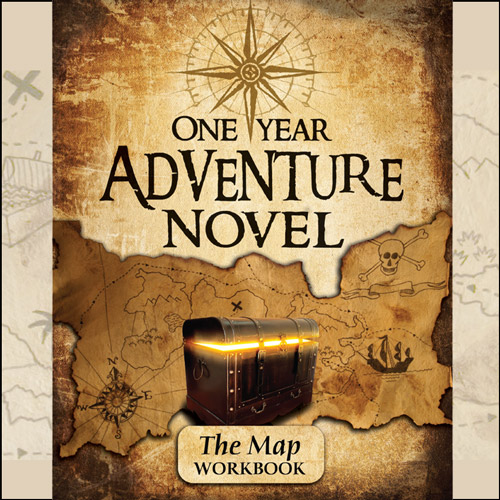Hunting the Elusive Novel Title
 By Gabrielle Schwabauer, Staff Writer
By Gabrielle Schwabauer, Staff Writer
As a One Year Adventure Novel staff member, I have seen many, many novels pass through the Student Forum, the workshops, and the annual Student Novel Contest. Unfortunately, most are burdened with titles that would never inspire a second glance on a bookstore shelf. For my part, I struggled so much with titling my first novel that it still doesn’t have a name.
Hunting for the “perfect” title—or even just a title that fits—is hard.
It’s not a challenge unique to new writers. Even compelling, well-crafted stories with sparkly prose and rock-solid characters, written by experienced authors, can fall prey to the boring title trap.
A few months ago, I asked myself: Could I compile a list of unique or especially fitting titles and use the data to extrapolate some of the common threads?
What makes a good title . . . good?
First, I scrolled through my Goodreads account and copied down fifteen titles that, to me, fit their stories well and were unusual enough to create interest. (This is not a recommendation list, by the way.)
- A Wrinkle In Time, by Madeleine L’Engle
- To Kill a Mockingbird, by Harper Lee
- Ender’s Game, by Orson Scott Card
- And Then There Were None, by Agatha Christie
- Permanent Rose, by Hilary McKay
- Lord of the Nutcracker Men, by Iain Lawrence
- The Girl Who Circumnavigated Fairyland in a Ship of Her Own Making, by Catherynne Valente
- Pictures of Hollis Woods, by Patricia Reilly Giff
- Drums, Girls, and Dangerous Pie, by Jordan Sonnenblick
- Come Sing, Jimmy Jo, by Katherine Paterson
- Lord of the Flies, by William Golding
- The Horse and His Boy, by C.S. Lewis
- Mick Harte Was Here, by Barbara Park
- The Hitchhiker’s Guide to the Galaxy, by Douglas Adams
- How to Steal a Dog, by Barbara O’Connor
Now it’s time for a little thought experiment. Take one of the titles on that list and try to attach it to a different book. Is there another novel that would fit the title A Wrinkle in Time?
For most of those titles, the answer is no. Sure, you might be able to find another book with both a horse and a boy as key characters, but the title still narrows your search pretty considerably.
A good title is . . . SPECIFIC
Choose a title that applies to your book in a precise, meaningful way. If you’re considering Journey to Courage, think about how many other books could also accurately be called Journey to Courage. The Fellowship of the Ring, for example. Bridge to Terabithia. A Wrinkle in Time. It’s probably not a very strong title if it could easily be associated with a handful of other novels as well.
Eliminate vagueness. Embrace precision.
(And most of the time, it’s best to do this without ever incorporating made-up words from your story world.)
A good title is . . . REFERENTIAL
No, I don’t mean fandoms.
A title’s specificity often comes from its ability to self-reference. To be clear, I am still not suggesting that you use only made-up fantasy words in your title. This is where the precision comes in. How can you make your title point to a clear, measurable moment or element of your story? Journey to Courage might fit your story just fine, but it points only to outward ideas: the concept of a journey and the concept of courage. It doesn’t point to anything that is specific to your novel.
• A Wrinkle In Time references the explanation our heroine receives for how she is going to travel through time. When Mrs. Whatsit demonstrates the concept by literally wrinkling her skirt, we connect the time/space travel to one specific image.
• To Kill a Mockingbird references a quoted phrase from something a character says.
• Ender’s Game references the central unique concept of the story.
• And Then There Were None references a line from the nursery rhyme that is repeated throughout the story.
• Permanent Rose references the name on our heroine’s birth certificate, and also a paint color.
• The Girl Who Circumnavigated Fairyland in a Ship of Her Own Making references the protagonist and the journey she takes in the story’s central location.
• Drums, Girls, and Dangerous Pie references the terrible food-concoction our narrator’s little brother makes.
• The Horse and His Boy references the unique relationship between these two characters—the boy belongs to the horse rather than vice versa.
• The Hitchhiker’s Guide to the Galaxy references the author’s invented manual for space travel that the people within his story world use.
• How to Steal a Dog references the notebook the protagonist keeps for herself as she plans her dog-theft.
A good title is . . . MULTIPURPOSE
Many of the best titles accomplish more than one thing at once. Often the title is a reference to a symbolic element of the story, and so encapsulates both an internal and external conflict. Put simply, good titles frequently mean two things. For example:
Ender’s Game
A central feature of the story is the game Ender plays, but the title has a double meaning both because it is not really a game, and because it does not truly belong to Ender. He is being manipulated and forced—the true game is the one being played behind his back.
And Then There Were None
References a poem used repeatedly throughout the book, which has a double meaning in itself. It also points to the central element of this murder mystery: ten people are trapped together on a piece of property and begin to die one by one.
Permanent Rose
Permanent Rose is our narrator’s actual name. Her mother called all of her children after colors on her paint chart. Rose was born prematurely and looked like she might die for a long time, so her mother called her “Permanent Rose” as a kind of promise. The book is also about Rose’s fears regarding impermanence in her own life and family.
Lord of the Nutcracker Men
During World War I, a young boy plays with tiny nutcracker soldiers as a way to cope with his fears about his own father’s deployment. He is the “lord of the nutcracker men,” but the captain (or lord) of the nutcracker soldiers also becomes a metaphor for the absent father.
Pictures of Hollis Woods
Our narrator, Hollis Woods, likes to draw to release tension. She captures her life through the pictures she makes. The story is also told in a snapshot style, alternating between the recent past and the present to give the reader many different “pictures of Hollis Woods.”
Come Sing, Jimmy Jo
The book is about Jimmy Jo, a young boy who sings in a country band with his family. However, the commanding phrasing of this title hints at the story’s darker undertones—the weight of pressure and expectation from family and fans alike that he has to carry.
Lord of the Flies
The book’s title is both a term used for Satan and a phrase that exposes the futility of the boys’ animalistic behavior. They fight for control, for power, but in the end they can only hope to become lords of death and decay.
Mick Harte Was Here
This title is a phrase the protagonist writes in wet cement, a common phrase children etch into things. Mick Harte is the narrator’s dead brother, and the book is her tribute to him, her way of letting us know that “Mick Harte was here.”
And finally:
A good title . . . FITS THE TONE
• A Wrinkle In Time is a mysterious, unsettling, and exciting title.
• To Kill a Mockingbird has a mournful, literary sound.
• And Then There Were None is ominous and creepy, like a good murder mystery
• Permanent Rose centers around one person and her defining trait, just like the novel itself.
• The Girl Who Circumnavigated Fairyland in a Ship of Her Own Making is flowery, poetic, and whimsical.
• Drums, Girls, and Dangerous Pie already foreshadows the narrator’s jocular style.
• Lord of the Flies sounds dark and foreboding.
• Mick Harte Was Here implies history and loss.
• The Hitchhiker’s Guide to the Galaxy sounds tongue-in-cheek and lighthearted.
• How to Steal a Dog is straightforward and a little bit humorous, just like our narrator.
Of course, a good title doesn’t have to do these things. And a good novel can succeed without having a particularly great title. Bridge to Terabithia is the perfect title once you’ve already read the book, but to an outsider, it just sounds like some kind of fantasy story. (It’s not.)
So these aren’t rules to be followed without fail. Several titles on my list don’t even do all four things. Some great titles can be vague. Some great titles don’t point to a specific part of the book. But if you, like me, struggle to find an interesting title for your novel, one that just feels like it fits . . . maybe this list can be of some use.
…
What are your favorite novel titles? Do any of them line up with these strategies?
…
About Gabrielle
Gabrielle Schwabauer has loved stories for as long as she can remember. (The Lord of the Rings holds the top spot, as it has for twelve years running.) She likes reading books, playing video games, eating pancakes, looking at pictures of sloths, and having already written today.




Oh my gosh Gabrielle – this is so good! You have so astutely analyzed what makes these titles work, so it should become easier for us to apply these principles ourselves. THANK YOU!
PS. I think Mr S should add this to the OYAN curriculum! It is going into my reference folder!